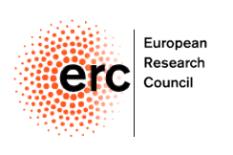Bekker-Jensen Group
The overarching aim for our group is to understand the molecular details of cellular stress responses and how they contribute to human diseases such as cancer and aging-related maladies.

The overarching aim for our group is to understand the molecular details of cellular stress responses and how they contribute to human diseases such as cancer and aging-related maladies. We are especially interested in understanding the mechanisms by which the MAP kinases p38 and JNK become activated in response to cellular stress insults such as ribosomal impairment, oxidative stress and high osmolarity, and how such signaling drives or protect against pathological cellular changes. Importantly, the same signaling pathways are crucial for inflammatory responses, adding to the relevance of our work for a range of human diseases.
Mechanisms of MAP kinase activation after diverse stress stimuli.
The molecular mechanisms responsible for activation of p38 and JNK after stress stimuli are vastly understudied compared to the mechanisms governing activation of these kinases after extra-cellular receptor-mediated stimulation. In an attempt to fill this gap in our understanding of cellular stress responses, we are working to identify the unknown or poorly studied signalling components working upstream of MAP kinases. To this end we employ siRNA screens and high-content microscopy techniques combined with a range of biochemical and cell biological techniques.
Identification of novel stress signaling pathways.
Employing proteomics, we are continuously searching for new cellular target of p38 and JNK signalling. We have uncovered a number of such targets, and we are currently undertaking detailed investigation of their biological ramifications. Several of these projects focus on RNA-binding proteins, and regulation of post-transcriptional gene regulation is a common denominator for many effector pathways in cellular stress as well as inflammatory responses.
Requirement of cellular stress responses for cancer development and tumour cell maintenance.
Cancer cells are more metabolically active than normal healthy cells, and consequently they have an increased requirement for functional stress signalling pathways to combat the detrimental effects of reactive oxygen species and other metabolic by-products. We hypothesize that these pathways will represent future targets for therapeutic intervention in cancer therapy. We are investigating these ideas in both cell culture and mouse models.
- Hansen RK, Mund A, Poulsen SL, Klement K, Räschle M, Romero RS, Offermanns S, Worzfeld T, Grosse R, Brandt DT, Rozell B, Mann M, Goodarzi AG, Daniel J, Mailand N, Bekker‐Jensen S. (2016) SCAI promotes DNA double-strand break repair in distinct chromosomal contexts. Nature cell biology. 2016 Dec;18(12):1357-1366.
- Tollenaere MAX, Villumsen BH, Blasius M, Nielsen JC, Wagner SA, Bartek J, Beli P, Mailand N, Bekker‐Jensen S. (2015) p38‐ and MK2‐dependent signalling promotes stress‐induced centriolar satellite remodelling via 14‐3‐3‐dependent sequestration of CEP131/AZI1. Nature communications. Nov 30;6:10075.
- Thorslund T, Ripplinger A, Hoffmann S, Wild T, Uckelmann M, Villumsen B, Narita T, Sixma TK, Choudhary C, Bekker-Jensen S*, Mailand N. (2015) Histone H1 couples initiation and amplification of ubiquitin signalling after DNA damage. Nature. Nov 19;527(7578):389-93.
- Räschle M, Smeenk G, Hansen RK, Temu T, Oka Y, Hein MY, Nagaraj N, Long DT, Walter JC, Hofmann K, Storchova Z, Cox J, Bekker-Jensen S*, Mailand N*, Mann M*. (2015) Proteomics reveals dynamic assembly of repair complexes during bypass of DNA cross-links. Science. May 1;348(6234):1253671
- Tollenaere MA, Mailand N, Bekker-Jensen S. (2015) Centriolar satellites: key mediators of centrosome functions. Cellular and molecular life sciences. Jan;72(1):11-23
- Villumsen BH, Danielsen JR, Povlsen L, Sylvestersen KB, Merdes A, Beli P, Yang YG, Choudhary C, Nielsen ML, Mailand N, Bekker-Jensen S. (2013) A new cellular stress response that triggers centriolar satellite reorganization and ciliogenesis. EMBO journal. Nov 27;32(23):3029-40.
- Mailand N, Gibbs-Seymour I, Bekker-Jensen S. (2013) Regulation of PCNA-protein interactions for genome stability. Nature reviews molecular and cellular biology. May;14(5):269-82.
- Bekker-Jensen S., Danielsen JR., Fugger K., Gromova I., Nerstedt A., Bartek J., Lukas J. and Mailand N. (2010). HERC2 coordinates assembly of genome caretakers on damaged chromosomes. Nature cell biology. Jan;12(1):80-6.
- Doil C., Mailand N., Bekker-Jensen S., Menard P., Larsen D., Pepperkok R., Ellenberg J., Panier S., Durocher D., Bartek J., Lukas J. and Lukas C. (2009). RNF168 binds ubiquitin and couples RNF8 recruitment with assembly of repair proteins on damaged chromosomes. Cell. Feb 6;136(3):435-46.
- Mailand N.*, Bekker-Jensen S.*, Melander F., Faustrup H., Bartek J., Lukas C. and Lukas J. (2007). RNF8 ubiquitylates histones at DNA double-strand breaks and promotes assembly of repair proteins. Cell. Nov 30;131(5):887-900.
- Bekker-Jensen, S., Lukas, C., Kitagawa, R., Melander, F., Kastan, M.B., Bartek, J., and Lukas, J. (2006). Spatial organization of the mammalian genome surveillance machinery in response to DNA strand breaks. Journal of cell biology. Apr 24;173(2):195-206.
- Bekker-Jensen, S., Lukas, C., Melander, F., Bartek, J., and Lukas, J. (2005). Dynamic assembly and sustained retention of 53BP1 at the sites of DNA damage are controlled by Mdc1/NFBD1. Journal of cell biology. Jul 18;170(2):201-11.
 Group Leader
Group Leader
Simon Holst Bekker-Jensen
Professor of Cellular Stress Responses
sbj@sund.ku.dk
(+45) 35 32 50 24 / (+45) 20 20 49 93
CV, Publications, etc.





